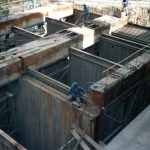ICESP VI – Budapest, Hungary, 1996
The International Conference on Electrostatic Precipitation (ICESP) is the official conference of the International Society for Electrostatic Precipitation (ISESP). The following is a list of papers from the VI ICESP Conference under their respective topic. Click on the papers title to view the complete paper in PDF format.
Air Toxics
- 002 – Control of Trace Elements in Combustion Flue Gas by a Corona Discharge Activated Conditioning Agent and Electrostatic Precipitator
- 008 – Application of Wet Type Electrostatic Precipitator for Boiler Plants
- 021 – Improving Collection of Toxic Fine Particles in ESPs
- 027 – An Experimental Study of the Performance of an ESP Operating Downstream From a Semi-Dry Desulphurization Unit
Control and Design
- 035 – Emission Control during Transition Periods Using an Expert Supervisory Control System
- 045 – Electrostatic Precipitator Combined Pulse Charging Section with Moving Electrode Section for High Resistivity Dust
- 057 – Fundamental Characteristics and Collection Efficiency of a Model Precipit
- 063 – Back Corona Control with Help of Advanced Microprocessor Enhances Performances
- 071 – Field Testing of Acoustical Cleaning of Electrostatic Precipitators
- 080 – Self Exploring ESP Rapping Optimization System
- 087 – Improved Cleaning of High Voltage Insulators in ESP
- 094 – Diagnostics and Control of Electrode Rapping System
- 100 – Rigid Discharge Electrode and Wide Spacing Electrostatic Precipitators in Poland
Modeling
- 107 – An Efficient Pseudo-Transient Solution Method for Monopolar Corona with Charge Advection and Diffusion
- 113 – Precipitation Modeling by Calculating Particle Tracks in Simulated Flow Fields
- 124 – Removal of Submicrometer Dust Particles by a Charged Spherical Collector
- 130 – A Model of the Non-Stationary Charge Flow in an Electrostatic Precipitator
- 137 – Effective Solution of 3D Charge Coupled Problems in Electrostatic Precipitators
- 144 – Discharge of Impulse Series in Presence of Space Charges
- 154 – A Finite Element Method for Modeling 3D Field and Current Distributions in Electrostatic Precipitators with Electrodes of Any Shape
- 160 – Modeling of Particle Deposition on the Collecting Plates of Electrostatic Precipitator
- 166 – Three-Dimensional Corona Current Distribution in Complex ESP Configurations
- 172 – Advance of Field Calculation Method in Electrostatic Precipitators with Non-Cylindrical Corona Electrodes
- 178 – Numerical Computation of Ionized Fields in Electrostatic Pulse Powered Precipitators
- 184 – Modeling of the Velocity Field in Electrostatic Precipitators
- 190 – Motion of Macroscopic Particles in Electric Field
Operation and Upgrade
- 197 – Operating Experience of a Pulse ESP at a Modern 500 MW Coal Fired Power Plant in Japan
- 203 – Aspects of ESP Upgrading
- 209 – Performance Evaluation of an ESP Unit Using Low Grade Coa
- 215 – Economical Comparison of Conventional and Pulsed Electrostatic Precipitators in Industrial Applications
- 221 – Exploitation Experience of the Cooperation of an Electrostatic Precipitator and a Desulphurization Installation
- 227 – Use of Charged Liquid Aerosols for Increasing of the Efficiency of the Process of Dust Precipitation
- 232 – Possibilities of Making Use of Integrated Emission Monitoring System for Inspection of Electro Precipitators Operation
- 238 – Skewed Gas Flow Technology Improves Precipitator Performance Eskom Experience in South Africa
- 244 – Precipitator Performance Improvement Program a Practical Approach
- 254 – An Energy Management System for Electrostatic Precipitator
- 262 – Romanian Technologies for the Utilization the Pulses in the Electrostatic Precipitation in Energetics and Cement Industry
Physics
- 269 – The Effect of Gravitational Settling in an Electrostatic Precipitator
- 275 – The Spectra of the Corona in an Electrostatic Precipitator
- 281 – Measuring and Modeling Mass Fluxes in ESP
- 293 – Studies on Electrostatic Precipitation at Temperatures around Acid Dewpoint
- 299 – Relations between Coal/Fly Ash Properties and Cohesive Forces in Electrostatically Precipitated Ash Layers
- 306 – Electrostatically Enhanced Core Separator System
- 312 – Recent Experience in Controlling Fine Particles in ESP
- 325 – Local Deposition of Particles in a Laboratory-Scale Electrostatic Precipitator with Barbed Discharge Electrodes
- 335 – Improved Discharge Electrode Design Yields Favorable EHD-Field with Low Dust Layer Erosion in Electrostatic Precipitator
- 343 – Fractional Efficiency Investigations under Back Corona Conditions Considering the Local Occurrence of Back Corona at the Dust Layer of Electrostatic Precipitators
- 353 – Studies of Dust Layer Formation on Electrostatic Precipitator Electrodes at Alternating Polarity Power Supply (Apps)
- 359 – The Study of Agglomeration and Collection Efficiency in Electrostatic Precipitators
- 365 – Investigations into the Local Mass Flux of Dust to be Precipitated at the Collecting Electrode
- 375 – Investigations on Particle Dynamics in a Plate Type Electrostatic Precipitator Using Double-Pulse Holography
- 382 – Experiments on Simultaneous Variation of Plate Spacing and Duct Length
- 388 – Conduction and Charging Phenomena in a Fluidised Bed of Solid Insulating Particles
- 394 – Fact: a Non-Traditional Fly Ash Conditioning Technology
- 400 – Measurement of Discharge Electrode Emission Characteristics in the Laboratory
- 406 – Particle Flow Field in a Commercial Design ESP during Intermittent Energization
- 417 – FGC as a Means for Cost-Effective ESPs for Low Sulfur Coals
- 427 – Flue Gas SO3 Conditioning for Improvement of Particle Collection in ESP
- 432 – Results of IES Utilities, Burlington Station SO3 Conditioning
- 438 – Impact of Ash Characteristics on Precipitator Performance
- 452 – Physical Simulation of the Particle Migration in ESP Part II Application Results
- 460 – The Evolution of Back Corona Conditions in an ESP
- 466 – The Effect of Size and Shape on Electrostatic Particle Charging Processes
Plasma Catalysis
- 473 – Application of Non-Thermal Discharge Plasma for Flue Gas Cleaning
- 479 – Non-Thermal Plasma Processing for Air Cleaning
- 485 – Decomposition of Methylmercaptan by Non Thermal Plasma
- 490 – Removal of the Ozone Layer Depleting Gases Using Non-Thermal Plasma Technology
- 495 – Optimizing Pulse Corona Characteristics for Removal of SO2 by Pulse Corona from Simulated Flue Gas
- 500 – VOC Removal by Plasma Cathalysis
- 505 Decomposition of Hydrocarbons by Back Corona Discharges
- 511 BackCorona Generated Plasma for Decomposition of NO2 in Oxygen-Free N2:NO2 Gas Mixture
- 517 No removal by Pulsed Corona Discharge in ESP with Irrigated Plate
- 523 Removal of Toulene from Air Stream by a Pulse Corona Plasma Reactor
- 529 Reduction of NOx from Natural Gas Combustion Flue Gases by Corona Discharge Radical Injection Techniques and Electrostatic Precipitators
- 535 The Reduction of NOx and SOx from Flue Gas Using Sub microsecond Pulsed Energization
- 544 Reduction of Chemical Pollutants in the Exhaust as of the Municipal Waste Incinerator by PPCP (Pulse Corona Induced Plasma Chemical Process)
- 550 Removal of NOx in a DC Corona Discharge Used in Wet Precipitators
- 555 Pulse Corona Discharge Investigations and Concept of Combined Effluents Cleaning from Dust and Oxides
- 562 NOx Removal Characteristics of Corona Radical Shower System
- 568 Effect of Non-Thermal Plasma on Carbon Dioxide
- 574 Removal of NO from Flue and Exhaust Gases Using Non-Thermal Plasma Technology
- 580 The use of Pulsed Corona Technology to Destroy VOCs, Dioxins and Furans at a Municipal Solid Waste Incinerator
Power Supply
- 587 Application of Pulse Power for Gas Cleaning Direct-Coupled Pulse Energization in ESP and Pulse Corona Induced Plasma Chemical Process
- 596 Design of a Low Cost Pulsed Power Supply for Electrostatic Precipitators Using Magnetic Switching Technique
- 602 Pulsed Energization Application to Cleaning of Flue Gases
- 608 The New Scope for EPPS Under the High Voltage Vacuum Switching Tubes – EBV Usage



